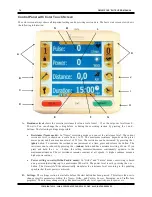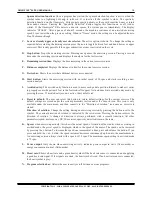
COPYRIGHT 2010 - 2020, ACCELERATED CARE PLUS CORP., ALL RIGHTS RESERVED
NOTE:
NOTE:
NOTE:
OMNICYCLE
®
ELITE USER MANUAL
27
The data is used to show the patient how tight or loose patient limbs are or if muscle hypertonia has
been reduced.
Motor power:
The set motor power (torque) has a greater effect on the patient’s legs with a smaller crank length
than with a longer crank length. The motor power setting limits the motor’s maximum torque output. It can be set to
between 2 and 22 Nm. Set the motor power as follows:
1
To
6
= Adjustable crank length settings
1
= Very short crank length
6
= Very long crank length
Lbs. = Mass (weight) of patient
M = Motor torque (power setting)
With a short crank length and a high motor power setting, the patient can be subjected to very strong
forces. The motor power for the upper extremity exerciser is approx. 30% of the power of the lower extremity
exerciser.
Spastic detector:
A “Neuro” function. This setting is used to specify the threshold at which the Omnicycle
®
Elite
sensors detect a spastic reaction on the part of the patient and stops the motor to minimize the risk of overstressing
the patient. For patients who may be subject to spasms, there are three different settings that may be used based on
specific symptoms or physical limitations:
•
Fine
for patients with very sensitive joints and tendons. At this setting even very slight resistance is enough
to stop the motor.
•
Medium
for patients with less sensitive responses.
•
Rough
for patients with pronounced spasticity. The exerciser does not stop until there is a large amount of
resistance.
The longer the crank length or the lower the motor power, the more sensitively the spasticity detection
responds. The shorter the crank length/the greater the motor power, the less sensitively the spasticity detection
responds.
















































